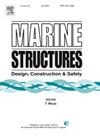Influences of interface bonding behavior on the arresting performance of CFRP buckle arrestors - Part II: Analysis
IF 5.1
2区 工程技术
Q1 ENGINEERING, CIVIL
引用次数: 0
Abstract
The CFRP buckle arrestor, designed as an innovative arresting device, effectively enhances the local circumferential stiffness of subsea pipes, serving as a barrier to prevent the spread of buckling. This arrestor consists of multiple layers of adhesive and CFRP, carefully wound around the subsea pipes in several loops. In the present work, a fully-coupled nonlinear finite element (FE) model is proposed to simulate the collapse and its evolution of tubes wrapped with CFRP arrestors, which is verified by the previous experimental results. The interface bonding performance between tubes and CFRP arrestors is characterized by the surface-based cohesive behavior in ABAQUS, and the circumferential, axial, and normal bonding behavior is defined according to the measured bonding strength and slip. The failure mechanism at the interface between the tubes and CFRP arrestors is revealed. Subsequently, broad parametric analyses are numerically performed, covering key geometric and material parameters as well as interface bonding properties. Finally, based on the extensive FE results, optimized empirical formulas are established to assess the crossover pressure and arresting efficiency of CFRP buckle arrestors under flattening-mode.
界面结合行为对CFRP扣式避雷器拦阻性能的影响。第二部分:分析
CFRP扣式拦阻器是一种创新的拦阻装置,可有效提高海底管道的局部周向刚度,起到防止屈曲扩散的屏障作用。这种避雷器由多层粘合剂和CFRP组成,小心地缠绕在海底管道上。本文提出了一种全耦合非线性有限元模型来模拟CFRP阻雷器包裹管的坍塌及其演变过程,并与前人的实验结果进行了验证。在ABAQUS中,CFRP减震器与钢管之间的界面粘接表现为基于表面的粘接行为,并根据测量的粘接强度和滑移定义了周向、轴向和法向粘接行为。揭示了钢管与CFRP避雷器界面处的破坏机理。随后,进行了广泛的数值参数分析,包括关键的几何和材料参数以及界面粘合性能。最后,在大量有限元结果的基础上,建立了优化的经验公式,以评估CFRP扣式避雷器在扁平模式下的交叉压力和拦阻效率。
本文章由计算机程序翻译,如有差异,请以英文原文为准。
求助全文
约1分钟内获得全文
求助全文
来源期刊

Marine Structures
工程技术-工程:海洋
CiteScore
8.70
自引率
7.70%
发文量
157
审稿时长
6.4 months
期刊介绍:
This journal aims to provide a medium for presentation and discussion of the latest developments in research, design, fabrication and in-service experience relating to marine structures, i.e., all structures of steel, concrete, light alloy or composite construction having an interface with the sea, including ships, fixed and mobile offshore platforms, submarine and submersibles, pipelines, subsea systems for shallow and deep ocean operations and coastal structures such as piers.
 求助内容:
求助内容: 应助结果提醒方式:
应助结果提醒方式:


